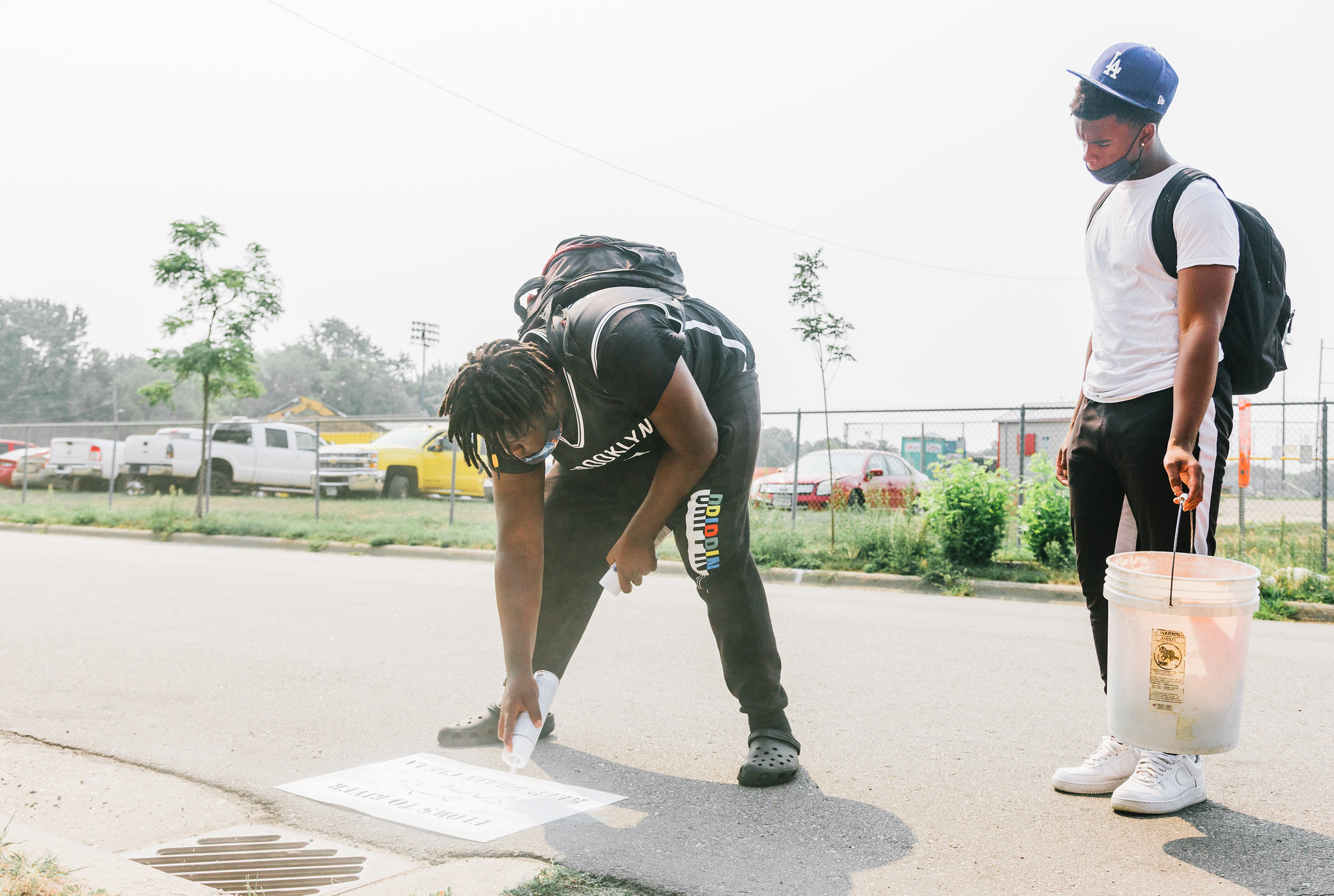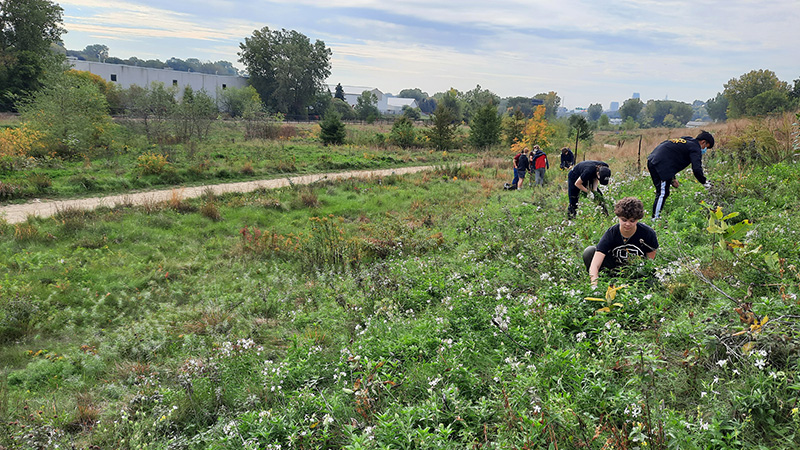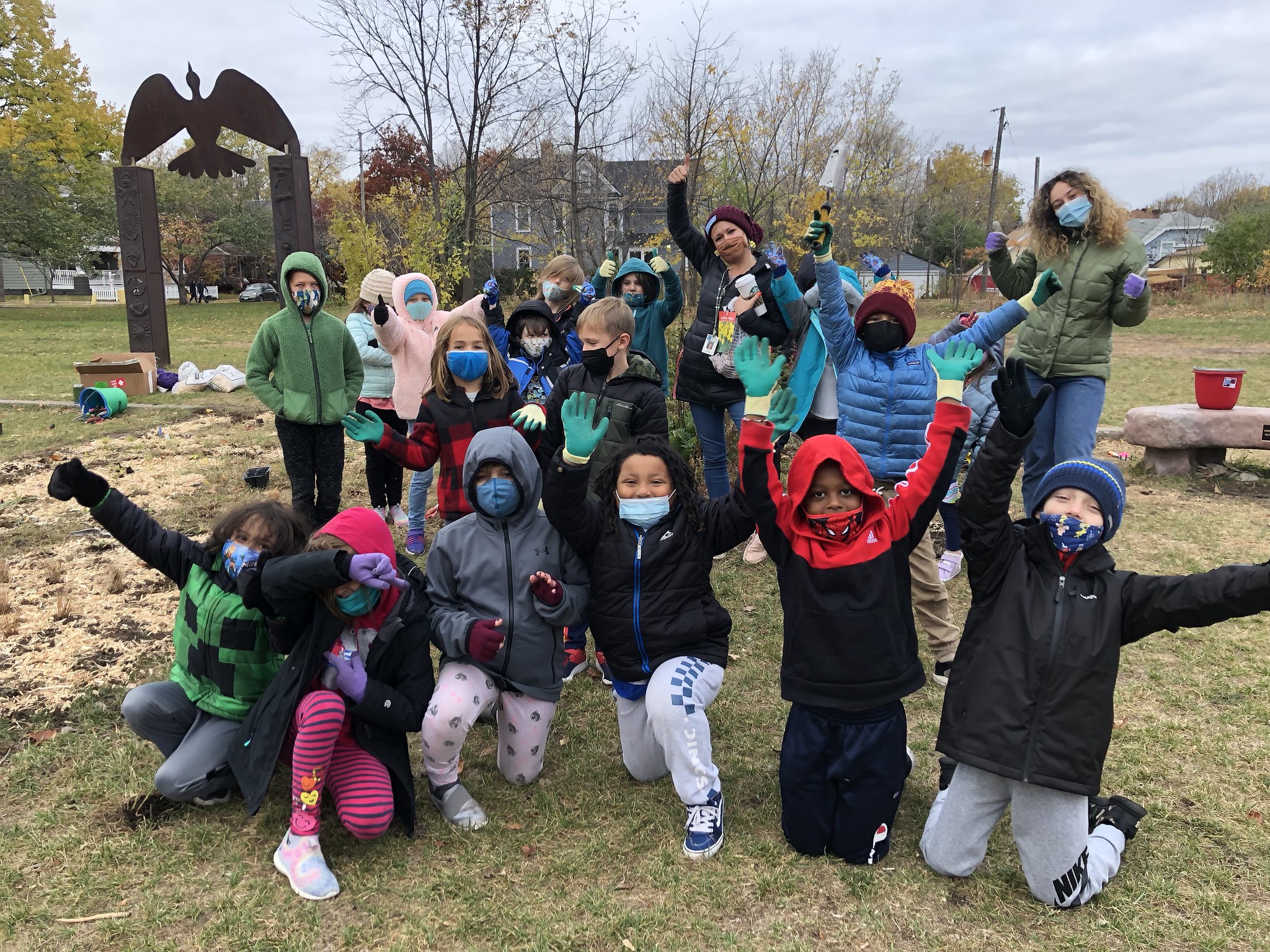Thank you, 2021 youth river stewards!
This fall, a class at J.J. Hill Montessori planted a rain garden on their school grounds with FMR. Students also learned about protecting water quality and the importance of planting native species.
In 2021, young volunteers showed up for the river. FMR worked with classrooms and youth groups virtually and outdoors, connecting with our environment and engaging in restoration and stewardship.
Thanks to young river stewards from 21st Century Academy, Como High School, Great River School, Hamline University Gymnastics Team, Hennepin Avenue United Methodist Church, Incarnation Lutheran Church, Macalester College, Minnesota Transitions Charter School, Open World Learning Community, Saint Anthony Elementary School, Saint Paul Academy, and countless others for taking the initiative to make volunteering a priority during the pandemic, and for all they contributed through our education and stewardship programs.
Stenciling for water quality in St. Paul
One COVID-safe activity is FMR’s storm drain stenciling program. Stenciling kits are available for no-contact pickup at our office in downtown St. Paul for community, school or family groups when temperatures are above 40 degrees. We continued offering stenciling kits in 2021, and enjoyed meeting up with several groups in person as well.
This year, more than 400 young FMR volunteers stenciled more than 1,281 storm drains with educational messages, distributed more than 1,734 related educational flyers to neighbors and collected trash. A special shout-out to our summer stenciling intern Marcellus Dees for his commitment to stewardship through our stenciling program this year! Read more about the impacts of this program in 2021.
Stenciling messages next to storm drains is an effective way to remind our community that storm drains are directly connected to the river and wildlife.
Seeing "Keep 'em clean, Drains to river" painted on our street corners calls attention to the fact that there is not a magic filtration system under our streets — whatever we see along the curb, gutter or roadside gets carried into the river when it rains and when snow melts. Road salt and cigarette butts are some of the worst pollutants. But leaves, grass, fertilizers, pesticides, oil, gas, paint, antifreeze and everyday trash pollute the river too.
 High schoolers from 21st Century Academy stencil storm drains in the Above the Falls region of Minneapolis. In addition to painting educational messages next to storm drains, volunteers clean the area around them and distribute flyers to nearby homes and businesses full of pollution reduction tips. (Photo: Tamar Patterson for FMR)
High schoolers from 21st Century Academy stencil storm drains in the Above the Falls region of Minneapolis. In addition to painting educational messages next to storm drains, volunteers clean the area around them and distribute flyers to nearby homes and businesses full of pollution reduction tips. (Photo: Tamar Patterson for FMR)
Restoration activities
We rely on youth volunteers for continued monitoring, research and restoration at sites like Trout Brook Nature Sanctuary in St. Paul and Vermillion River Linear Park in Hastings. In 2021,122 youth donated their time to stewarding special places like these. These youth spent 366 hours engaged in pollinator surveys, worm surveys and invasive species removal.
Hastings High School field biology students surveyed pollinators and tended to Vermillion River Linear Park for the seventh consecutive year thanks to an important partnership with their teacher, Mr. Beattie, who is retiring this winter. We're grateful for all his collaborations over the years.
Saint Paul Academy students were able to return to Crosby Farm Park to survey invasive plants and worms after a year of remote learning due to COVID-19.

Como High School students tend the prairie at Trout Brook Nature Sanctuary in St. Paul. Como students have returned to this site for years to plant and tend the prairie and learn about monitoring practices.
Classroom education
While we always enjoy the outdoors, FMR also spends time connecting with teachers and classrooms virtually as a way to deepen our learning in the field. In 2020, we reformatted several in-person lessons to be available virtually, and we've continued to share our lesson plans with teachers.
In 2021, we piloted our Cultural Landscapes lesson, which explores the history of our land and individuals' connections to place. Whether we're sharing this lesson with elementary students, high schoolers, or adults, the content inspires dialogue and connection through the diverse and unique ways people connect to and take care of the outdoors. We've enjoyed going deeper with our young river stewards and discussing our relationships to stewardship.
Environmental Stewardship Institute and Youth Council
In the third year of FMR's Environmental Stewardship Institute (ESI), our ten fellows focused on the guiding theme of Resilient Waters: Building Community and Connection.
In the midst of the pandemic and drought this summer, we explored what makes our waters, our communities and ourselves resilient. Our fellows modeled resiliency through the summer, meeting in a park as well as online, touring sites in the rain and completing in-depth projects in a matter of seven weeks.
And this fall, we hired seven inaugural ESI Advisory Council members to take on group projects during the school year. As the founding members, the high school students are building a foundation for young environmental leaders to take action and have an impact in their communities.
Team up with us in 2022
2021 was an exciting year for the youth program, and we're thankful for all our young stewards.
It's not too early begin planning for hands-on restoration outings and lessons for your class or youth group in the coming year! Stay tuned for more information on how to sign up your classroom for stewardship experiences in early 2022. In the meantime, check out our menu of offerings, find a restoration site near you, or contact FMR Youth Coordinator Ashley O'Neill Prado at education@fmr.org for more information.
Thanks to our funders
We're grateful to all our funding partners for sustaining FMR's youth programming: Capitol Region Watershed District, GroMoreGood Grassroots Grant, HB Fuller, Hardenberg, National Park Trust, Protolabs, St. Paul Public Works, 3M, United Way of Hastings, Youthprise and others.
